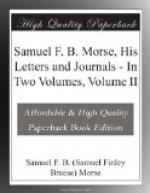I have hazarded the opinion that it was a kindly fate which frustrated the consummation of the Russian contract, and here again I venture to say that the Fates were kind, that Morse was right in saying that the “delays” would “turn out to be beneficial.” And why? Because it needed all these years of careful thought and experiment on the part of the inventor to bring his instruments to the perfection necessary to complete success, and because the period of financial depression, through which the country was then passing, was unfavorable to an enterprise of this character. The history of all inventions proves that, no matter how clear a vision of the future some enthusiasts may have had, the dream was never actually realized until all the conditions were favorable and the psychological moment had arrived. Professor Henry showed, in his letter of February 24, that he realized that some day electricity would be used as a motive power, but that much remained yet to be discovered and invented before this could be actually and practically accomplished. So, too, the conquest of the air remained a dream for centuries until, to use Professor Henry’s words, “science” was “ripe for its application.” Therefore I think we can conclude that, however confident Morse may have been that his invention could have stood the test of actual commercial use during those years of discouragement, it heeded the perfection which he himself gave it during those same years to enable it to prove its superiority over other methods.
Among the other improvements made by Morse at this time, the following is mentioned in the letter to Smith of July 16, 1842, just quoted from: “I have invented a battery which will delight you; it is the most powerful of its size ever invented, and this part of my telegraphic apparatus the results of experiments have enabled me to simplify and truly to perfect.”
Another most important development of the invention was made in the year 1842. The problem of crossing wide bodies of water had, naturally, presented itself to the mind of the inventor at an early date, and during the most of this year he had devoted himself seriously to its solution. He laboriously insulated about two miles of copper wire with pitch, tar, and rubber, and, on the evening of October 18, 1842, he carried it, wound on a reel, to the Battery in New York and hired a row-boat with a man to row him while he paid out his “cable.” Tradition says that it was a beautiful moonlight night and that the strollers on the Battery were mystified, and wondered what kind of fish were being trolled for. The next day the following editorial notice appeared in the New York “Herald":—
MORSE’S ELECTRO-MAGNETIC TELEGRAPH
This important invention is to be exhibited in operation at Castle Garden between the hours of twelve and one o’clock to-day. One telegraph will be erected on Governor’s Island, and one at the Castle, and messages will be interchanged and orders transmitted during the day.




